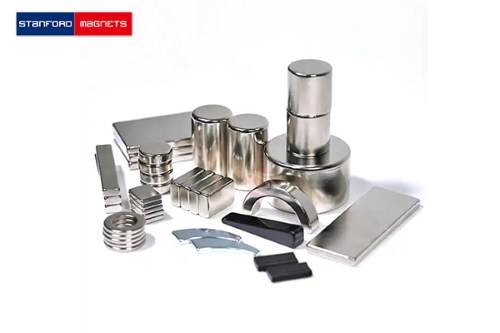Factors Affecting the Performance of Neodymium Magnets
Introduction
Neodymium magnets, or NdFeB magnets, are the strongest type of permanent magnets available commercially. Despite their superior performance, several factors can significantly influence their effectiveness. Understanding these factors is crucial for optimizing their application in various industries, from electronics to renewable energy.

1. Composition and Alloying Elements
The fundamental composition of neodymium magnets is an alloy of neodymium, iron, and boron. The exact proportions and the inclusion of additional alloying elements, such as dysprosium and terbium, can greatly affect the magnet’s properties:
- Neodymium (Nd): Provides the magnet with its primary magnetic properties.
- Iron (Fe): Contributes to the overall strength and magnetic saturation.
- Boron (B): Stabilizes the crystal structure, enhancing magnetic properties.
Alloying elements like dysprosium and terbium are often added to improve the magnet’s resistance to demagnetization, especially at high temperatures. However, the addition of these rare earth elements can increase costs and impact material availability.
2. Manufacturing Processes
The production process of neodymium magnets involves several critical steps. Each step must be carefully controlled to ensure the highest quality and consistency in the magnet’s performance.
- Sintering: The process of pressing and heating the NdFeB powder compacts the material, affecting the density and homogeneity of the magnet.
- Magnetization: The application of a strong magnetic field to the magnetized material determines the final magnetic orientation and strength.
- Coating: Neodymium magnets are prone to oxidation and corrosion. Protective coatings, such as nickel, zinc, or epoxy, are applied to prevent degradation and maintain performance.
Related reading: Types of Neodymium Magnet Coatings: Protecting the World’s Strongest Magnets
3. Temperature Stability
Temperature significantly affects the performance of neodymium magnets. These magnets have a maximum operating temperature range of about 150°C to 200°C, beyond which their magnetic properties can degrade. Key temperature-related factors include:
- Curie Temperature: The temperature at which the magnet loses its magnetic properties completely. For neodymium magnets, this is typically between 310°C and 370°C.
- Temperature Coefficients: Neodymium magnets have a negative temperature coefficient, meaning their magnetic strength decreases as the temperature rises. This makes them less suitable for high-temperature applications without proper thermal management.
Related reading: Maximum Operating Temperature VS. Curie Temperature
4. Size and Shape
The size and shape of a neodymium magnet influence its magnetic field distribution and overall performance. Larger magnets can generate stronger magnetic fields, but they are also more susceptible to mechanical stress and require more robust handling and protection. The shape affects the magnet’s flux distribution and can be optimized for specific applications to maximize efficiency and performance.
5. Quality Control and Standards
Strict quality control during manufacturing ensures that neodymium magnets meet specified performance criteria. Adherence to international standards such as ISO and ASTM helps maintain consistency and reliability across different batches and manufacturers.
6. Reliable Neodymium Magnet Manufacturers
The quality and reliability of neodymium magnets largely depend on the expertise and practices of their manufacturers. Some of the most reputable neodymium magnet manufacturers include:
- Stanford Magnets: With over two decades of experience, Stanford Magnets is known for producing high-performance neodymium magnets. They offer a wide range of products tailored to various industrial and commercial applications, emphasizing rigorous quality control and continuous innovation.
- Stanford Advanced Materials (SAM): SAM is a leading neodymium magnet manufacturer with a strong focus on research and development. The company produces magnets used in various applications, from automotive to renewable energy, offering customized solutions to meet specific customer needs.
Conclusion
The performance of neodymium magnets is influenced by composition, manufacturing processes, temperature stability, and neodymium magnet manufacturers. By carefully managing these factors, manufacturers can optimize the performance and longevity of neodymium magnets, ensuring their effective application in various high-tech industries.
As technology advances, ongoing research and development will continue to enhance the properties and capabilities of these powerful magnets. Reliable manufacturers play a pivotal role in this process, ensuring that high-performance neodymium magnets remain a cornerstone of modern technology.